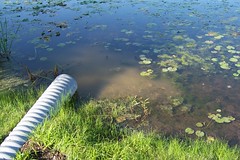
What looked to be a small stroke of genius in the fight against global warming has resulted in scientific disaster. Planktos, a California-based company that sell “carbon credits” to businesses looking to reduce their carbon footprint had planned to harness the photosynthetic power of algae to lower greenhouse gases - and make a tidy profit.
Algae come cheap, requiring light and water. They also require iron, which may be the sixth most abundant element in the Universe, but still relatively rare in the ocean. The small bits algae utilize are blown in by the wind and runoff from rivers and streams.
While some scientists and environmental groups object to their plan fearing harmful changes to the ecosystem, Planktos went ahead and dumped a hundred tons of iron dust mixed with seawater into international waters off the coast of the Argentina.
Expecting a plankton bloom and carbon credit riches to follow, their plans were literally eaten alive by a swarm of algae-loving shrimp. They did get their bloom, but it was not large, carbon dioxide capturing algae. Instead they promoted the large-scale bloom of haptophytes, a tiny algae common in the open ocean and extremely abundant in the fossil record. They are also the fellows responsible for the white foam you sometimes see on the edge of beaches.
Most importantly, however, they are the food of choice for the equally common copepod, a shrimp-like crustacean who complete with krill for forming the largest animal biomass on earth. And perhaps, the largest appetite.
Sometimes. brilliance arises from thinking outside the box. Seems this time the shrimp didn't get the memo. Instead they got a free pass to an All You Can Eat buffet.
As a friend recently pointed out, "we're all just prawns in the game."





Comments